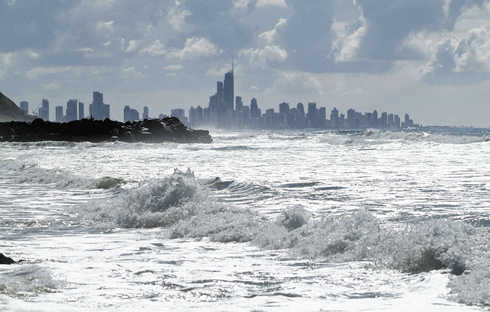
|
Published: 8 April 2013
Latest Climate Commission report: climate change fuelling wilder weather
The Climate Commission last week released a major report on extreme weather in Australia, collating the latest knowledge of the influence of climate change on heat, heavy rainfall, flooding, drought, bushfires, storm surges and cyclones.

|
|
A storm surge buffeting the Gold Coast, Queensland. Credit:
Bruce Miller/scienceimage
|
The report found that:
-
Climate change is already increasing the intensity and frequency of many extreme weather events with significant risks for Australians.
-
Australia’s southeast, including many of our largest population centres, stands out as being at increased risk from many extreme weather events – heatwaves, drought, bushfires and coastal flooding.
-
Key food-growing regions across the southeast and the southwest are likely to experience more droughts in the future.
-
There is a high risk that extreme weather like heatwaves, heavy rainfall, bushfires, droughts and cyclones will become even more severe over the coming decades, increasing the risks of adverse consequences to human health, agriculture, infrastructure and the environment.
-
Only strong preventative action, reducing greenhouse gas emissions deeply and swiftly, can gradually halt the trend to more extreme weather.
‘Climate change is making many extreme events worse in terms of their impacts on people, property, communities and the environment. We are very concerned that the risk of more frequent and more severe extreme weather events is increasing as we continue to emit more and more greenhouse gases,’ said Climate Commissioner, Professor Will Steffen.
Chief Commissioner, Tim Flannery, added: ‘Records are broken from time to time, but record-breaking weather is becoming more common as the climate shifts.
‘Only strong preventative action, with deep and swift cuts in emissions this decade, can stabilise the climate and halt the trend toward more intense extreme weather.’
Emergency services are already noting the need to prepare for a more extreme climate.
In a statement released in response to the report the Australasian Fire and Emergency Service Authorities Council, the peak body for emergency services, stated: ‘Fire and emergency service agencies need to plan strategically to identify how they would cope with the projected increase in frequency and intensity of extreme weather.’
While the Climate Commission has previously put out reports on extreme events, like Hurricane Sandy and the Angry Summer, this report provides a broader picture, taking a comprehensive look at how the climate has already shifted, the influence this has had on extreme weather in Australia so far, and the likely consequences for the future.
The report draws upon the latest research and observations from bodies including the CSIRO, the Bureau of Meteorology, Australia’s leading universities and their counterparts overseas.
The report highlights a number of important facts, including:
-
Heat: The number of record hot days in Australia has doubled since the 1960s. The summer of 2012/2013 summer set over 100 heat records, including the hottest summer, hottest month, and hottest day on record.
-
Bushfire weather: Extreme fire weather has increased in many parts of Australia, including southern NSW, Victoria, Tasmania and parts of South Australia, over the last 30 years.
-
Rainfall: Heavy rainfall has increased globally. Over the last three years Australia’s east coast has experienced several very heavy rainfall events, fuelled by record-high surface water temperatures in the adjacent seas.
-
Drought: A long-term drying trend is affecting the southwest corner of Western Australia, which has experienced a 15 per cent drop in rainfall since the mid-1970s.
-
Sea-level rise: Sea level has already risen 20 cm globally. This means that storm surges ride on sea levels that are higher than they were a century ago, increasing the risk of flooding along Australia’s socially, economically and environmentally important coastlines. For instance, since 1950 Fremantle has experienced a three-fold increase in inundation events.
The independent Commission was established in 2011 to provide an authoritative and trusted source of information on climate change science and solutions.
Source: Climate Commission



